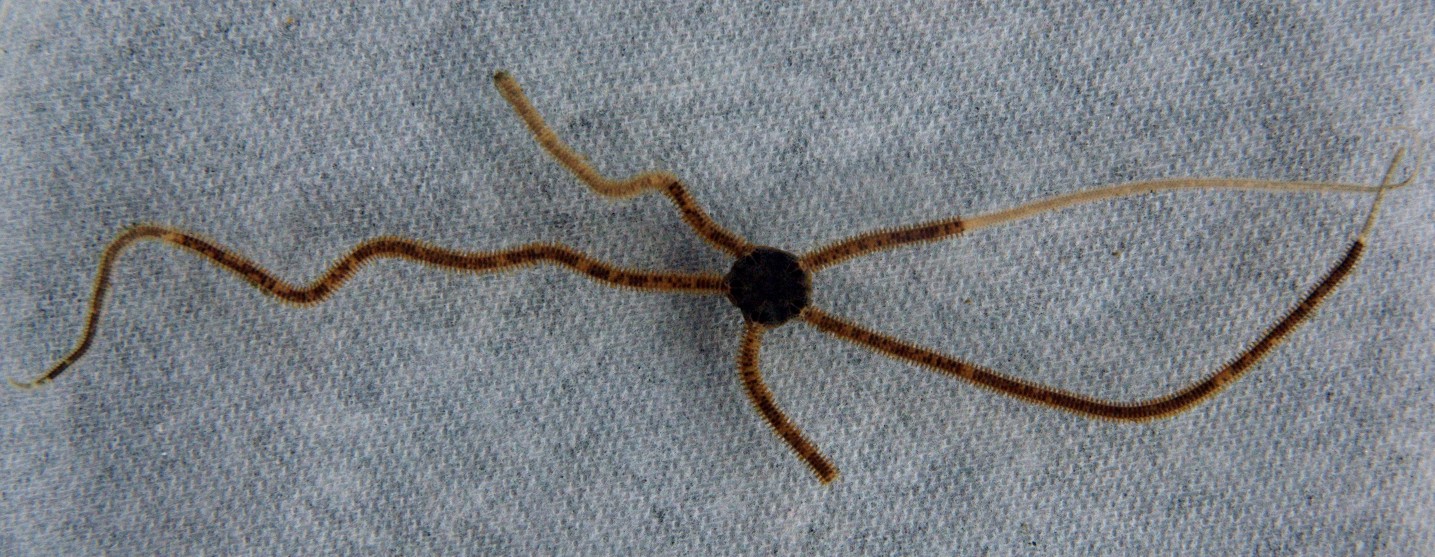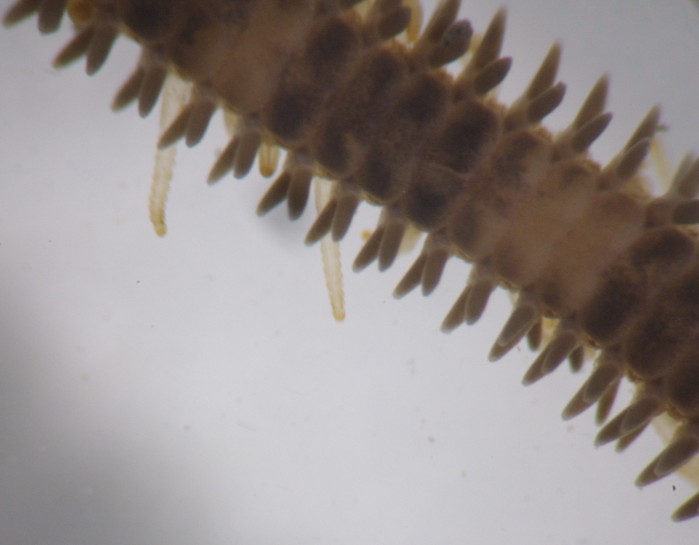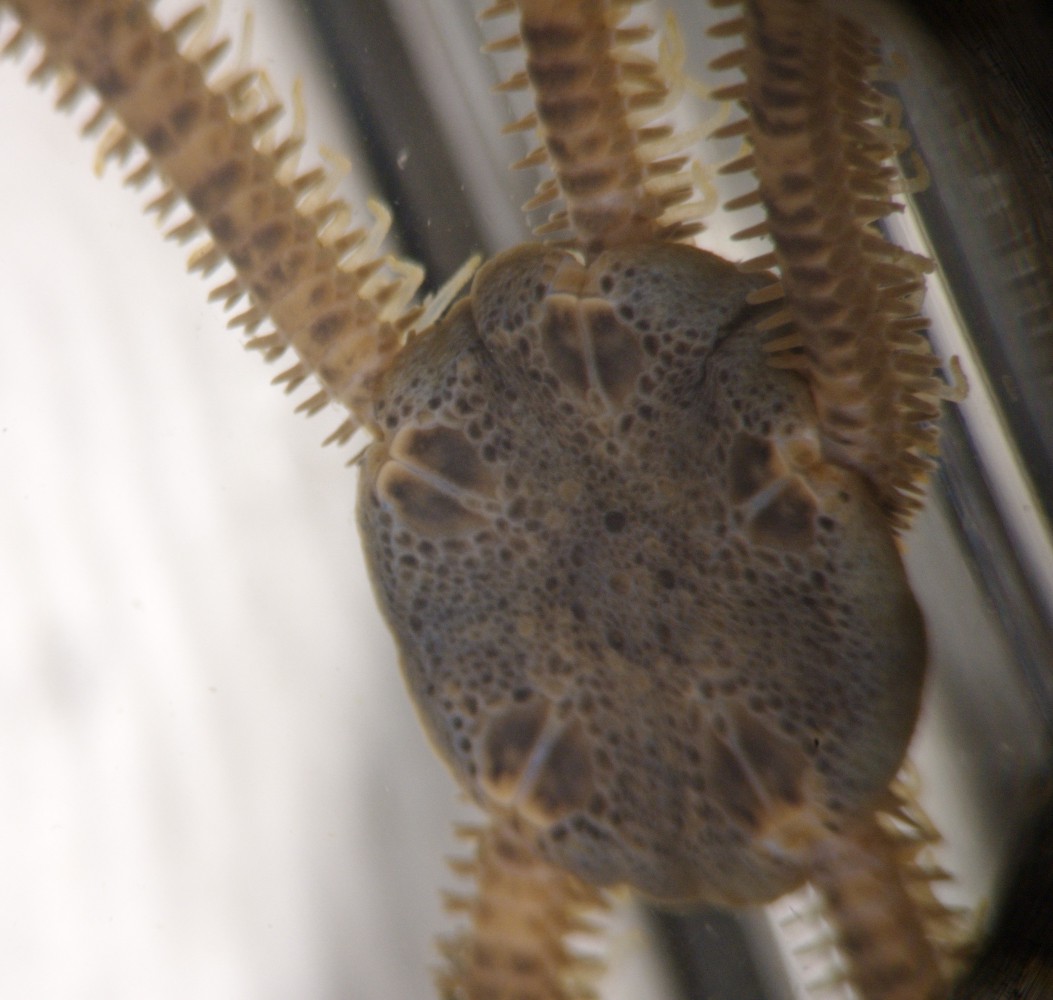Amphiodia urtica (Lyman, 1860)Common name(s): Burrowing brittle star, long arm brittle star |
|
| Synonyms: Diamphiodia urtica, Amphiodia barbarae |  |
|
Phylum Echinodermata
Order Ophiurida
Suborder Gnathophiurina
Family Amphiuridae
|
|
| Amphioidea urtica found intertidally in mud at Padilla Bay, June 2012 by Sarah Bewley and Melissa Moxey. Central disk is 9 mm diameter and total span is about 15 cm. Note that several arms are regenerating and others have recently broken but have not yet started regeneration. | |
| (Photo by: Dave Cowles, June 2012) | |
Description: The main plates on the aboral sides of the rays (arms) of this brittle star are oval, wider than long, and not interspersed with smaller plates (photo). The central disk is pentagonal and the rays do not insert into notches in the central disk. There are 3 oral papillae on each side of each jaw, all of which are similar in size or the central one is slightly shorter. The rays are about 12 to 21x as long as the central disk is wide. There are 3 pointed, slightly flattened arm spines on each side of the arm plates, plus curved spines on the aboral surface of the arms. Central disk up to 9 mm diameter, appears inflated, with small, thin scales which are larger near the radial shields (photo). Each radial shield (2 at the base of each ray) is next to its paired shield for most of its length but separated by a row of small scales at the end nearest the center of the central disk. Overall color is reddish to grayish brown; radial shields are paler at the end nearest the rays.
How to Distinguish from Similar Species:Ophiopholis aculeata is commonly found here but has reddish or purplish blotches and has smaller plates between the main plates on the rays. Amphiodia occidentalis is quite similar to A. urtica but has blunt, flattened arm spines. Amphiodia periercta is also quite similar but it is reddish-brown and has arm spines not at all flattened, plus can have a larger central disk (up to 15 mm) and the arm spines on the oral side are straight rather than curved.
Geographical Range: Alaska to Mexico
Depth Range: Intertidal (uncommonly) to at least 370 m.
Habitat: Lives in muddy areas, where it submerses itself in the mud and feeds by raising its arms and capturing particles from the water.
Biology/Natural History:
Sexes
are separate, and lifespan is about 5 years. Predators
include flatfish
such as sole, plus sand stars. The arms readily break off in
response
to predators (several arms on this individual have broken off and
regenerated),
and even the aboral
side
of the central
disk
can break off and be regenerated. This species is uncommon
near areas
with wastewater so is regarded as a bioindicator. The
polychaete Malmgreniella
lunulata sometimes is found living on the arms.
The copepod Caribeopsis
amphiodiae may live in the stomach. Carlton
(2007) says that
in Oregon and California this species occurs only subtidally.
Can
be very abundant in mud bottoms of the continental shelf.
| Return to: | |||
| Main Page | Alphabetic Index | Systematic Index | Glossary |
References:
Dichotomous Keys:Flora and Fairbanks, 1966
Kozloff, 1987, 1996
General References:
Harbo,
2011 (synonymized with A. periercta)
Lambert
and Austin, 2007
Morris
et al., 1980
Scientific Articles:
Web sites:
General Notes and Observations: Locations, abundances, unusual behaviors:
The aboral
side of
the central
disk
looks inflated and has many scattered scales. The radial
shields
are paired at the base of each ray
and in contact with each other for most of the length except for at the
end nearest the center of the disk, where they are separated by a thin
line of scales.

Aboral
view of arm.
The aboral plates on the rays
are oval and wider than long. The arm spines taper to a point
and
are nearly round. Tube
feet can be seen projecting below arm.
Authors and Editors of Page:
Dave Cowles (2012): Created original page
CSS coding for page developed by Jonathan Cowles (2007)
Rosario Invertebrates web site provided courtesy of Walla Walla University
